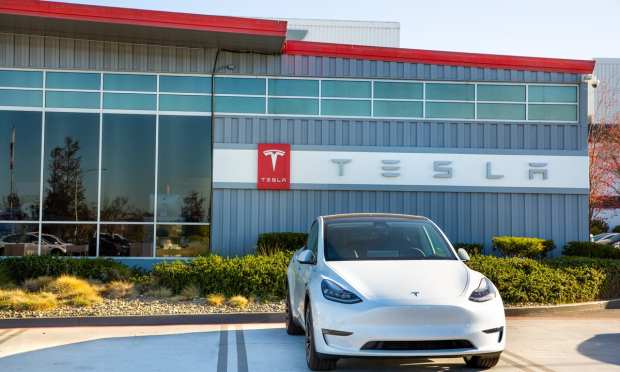Tesla’s Latest Boost And Automotive Subscriptions’ Shifting Future

After years of building buzz, it looks like Tesla’s long awaited self-driving car package is ready to make an appearance on the market, as the electric car company is rolling out its latest subscription offering for owners.
As of the Tesla app’s latest update, consumers have the option to purchase the firm’s Full Self-Driving package which adds several features for self-driving cars including navigating on autopilot and auto-park, as well as a full self-driving computer and traffic light and stop control.
The monthly cost of the upgrade will be $199 a month for new drivers, $99 a month for those who had previously bought into the now-discontinued Enhanced Autopilot package.
The offering isn’t exactly new, as consumers were previously able to purchase it in full for a single $10,000 payment — but the addition to the Tesla subscription package, though widely expected, is a change. According to Tesla, the subscription offering is premised on a “try before you buy” offering to give consumers an opportunity to experience the enhanced autonomous driving features Tesla can now offer without having to shell out a massive cost up front.
Currently the new subscription option is attached to the Full Self-Driving v9 release — a product that has been delayed several times since it was first announced in 2019, though a beta of the program did go out in early June. And even though the new subscription self-driving upgrade adds more autonomous functionality, Tesla was quick to note in the latest announcement that it will not make cars fully self-driving just yet. An email sent by the company specifies that the services “require active driver supervision and do not make the vehicle autonomous.”
Vehicle Subscriptions’ Winding Path
Tesla is not unique in the automotive industry in pushing into the world of subscriptions. Over the last several years, the likes of Toyota, Mercedes, Volvo, Tesla and BMW have all announced their individual takes on auto subscriptions. Unlike Tesla, which sells the cars and centers its subscription service on its self-driving capabilities, however, most other automakers are offering subscriptions to the cars themselves — offering users an ability to continually trade in and trade up their cars.
And those programs, notably, have a fairly inconsistent success rate with consumers. In 2018, for example, both Audi and BMW announced their new subscription programs to great fanfare, only to reverse course and shut them down earlier this year, owing to lack of demand from consumers.
“Facing increasing competition from Cars-as-a-Service companies like Zipcar and app-based ride-hailing services like Uber and Lyft, automakers have been experimenting with new ways of doing business,” Kelley reported. “Subscription services, it seems, may not be a workable answer. Still, BMW’s and Audi’s abandonment of subscriptions doesn’t mean the model is a failure.”
And in fact, the car subscription model also has the notable success case of the Volvo Cares program, which it modified to expand last year based on consumer enthusiasm. The reigning automotive subscription champ announced the latest upgrade to both its automobile line and its digital sales path earlier this year. The company has revealed its plans to release a whole new lineup of electric cars, including its second battery-only model, the C40 Recharge. And in a new move that separates the firm from a lot of automakers stepping into the EV field, Volvo has also announced that its electric vehicles will be for sale online only.
“The future of Volvo Cars is defined by three pillars: electric, online and growth,” said Lex Kerssemakers, head of global commercial operations. “We want to offer our customers peace of mind and a carefree way of having a Volvo, by taking away complexity while getting and driving the car. Simplification and convenience are key to everything we do.”
And as sticky.io CEO Brian Bogosian told Karen Webster in a conversation earlier this year, automotive subscription models can work just fine — the issue with the BMW and Audi programs was they simply didn’t work for the affluent consumers their products are normally aimed at.
At the end of the day, he said, the success of any subscription bundle hinges on hitting the sweet spot between a highly compelling package and pricing that customers can afford. Audi and BMW are both luxury brands that operate in an upper-market tier, noted Bogosian. At a few thousand dollars a month, the subscription offering didn’t speak to that customer segment, and was evidence that the more rarefied luxury tier might not have been the ideal jumping-off point for this kind of product.
“I think people will see significant uptake for car subscriptions, and I think some brands will be very successful with this kind of model,” Bogosian said. “For a mass-market car that addresses a big part of the total market opportunity, I think there will be a tremendous opportunity for a subscription term of three to five years, offering subscriptions at different price points. I think it comes down to what you’re providing to consumers, and whether it’s compelling or not.”
Making The Market Move
According to Bogosian, the market will move when the right innovative player creates the right bundle that actually motivates a shift in how consumers own cars — and more importantly, how they want to own cars. The field for who it will be, he said, is still wide open — it could be an established player like GM, or an up-and-comer like Tesla pioneering a unique take on the subscription. It could even be a player not in the market yet — like an Apple entrant.
“Once you see a big player move into this segment and offer something that’s compelling, I think it will change,” Bogosian said.
Tesla this week is making a bid to be the big player with the move that moves that market. Whether it works remains to be seen.
